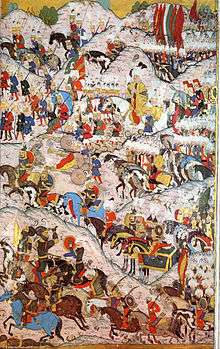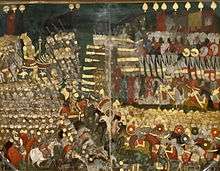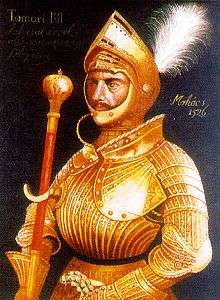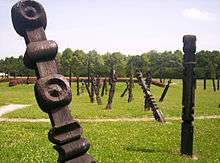Battle of Mohács
| Battle of Mohács | |||||||
|---|---|---|---|---|---|---|---|
| Part of the Ottoman wars in Europe and Ottoman-Hungarian Wars | |||||||
 Battle of Mohács 1526, Ottoman miniature[1] | |||||||
| |||||||
| Belligerents | |||||||
|
|
| ||||||
| Commanders and leaders | |||||||
|
Suleiman I Pargalı Ibrahim Pasha Malkoçoğlu Bali Bey Behram Pasha Gazi Hüsrev Bey |
Louis II of Hungary † Pál Tomori † György Zápolya † Stephen VII Báthory | ||||||
| Strength | |||||||
|
~70,000 men[2]
|
~25,000 to 30,000 men[3][4] (26,000 arrived on the battlefield) Gendarme heavy knights, (bore type) 85 cannons (but only 53 being used in the actual battle [5]) with explosive iron cannonballs and arquebusiers John Zápolya[6][7]'s 10,000, Croatian count Frankopan's 5,000 men-strong army and the Bohemian troops all did not arrive to the battlefield in time. | ||||||
| Casualties and losses | |||||||
| ~ 1,500[8] | ~ 14,000 to 20,000+[9][10] | ||||||
The Battle of Mohács (Hungarian: [ˈmohaːt͡ʃ]; Hungarian: Mohácsi csata, Turkish: Mohaç Muharebesi) was one of the most consequential battles in Central European history. It was fought on 29 August 1526 near Mohács, Kingdom of Hungary, between the forces of the Kingdom of Hungary, led by Louis II, and those of the Ottoman Empire, led by Suleiman the Magnificent. The Ottoman victory led to the partition of Hungary for several centuries between the Ottoman Empire, the Habsburg Monarchy, and the Principality of Transylvania. Further, the death of Louis II as he fled the battle marked the end of the Jagiellon dynasty in Hungary and Bohemia, whose dynastic claims passed to the House of Habsburg.
Background
Decline of royal power (1490–1526)
After the death of the absolutist King Matthias Corvinus in 1490, the Hungarian magnates, who did not want another heavy-handed king, procured the accession of Vladislaus II (reigned 1490–1516), King of Bohemia, because of his notorious weakness. He was known as King Dobře, or Dobzse in Hungarian orthography (meaning "good" or, loosely, "OK"), for his habit of accepting, without question, every petition and document laid before him.[11] The freshly elected King Vladislaus II donated most of the royal estates, régales and royalties to the nobility. By this method, the king tried to stabilize his new reign and preserve his popularity amongst the magnates. After the naive fiscal and land policy of the royal court, the central power began to experience severe financial difficulties, largely due to the enlargement of feudal lands at his expense. The noble estate of the parliament succeeded in reducing the tax burden by 70-80 percent, at the expense of the country's ability to defend itself.[12] Vladislaus became the magnates' helpless "prisoner"; he could make no decision without their consent.[13] The standing mercenary army (the Black Army) of Matthias Corvinus was dissolved by the aristocracy. The magnates also dismantled the national administration systems and bureaucracy throughout the country. The country's defenses sagged as border guards and castle garrisons went unpaid, fortresses fell into disrepair, and initiatives to increase taxes to reinforce defenses were stifled.[14] Hungary's international role declined, its political stability shaken, and social progress was deadlocked.
In 1514, the weakened and old King Vladislaus II faced a major peasant rebellion led by György Dózsa, which was ruthlessly crushed by the nobles, led by John Zápolya. After the Dózsa Rebellion, the brutal suppression of the peasants greatly aided the 1526 Turkish invasion as the Hungarians were no longer a politically united people. The resulting degradation of order paved the way for Ottoman pre-eminence. In 1521, the strongest Hungarian fortress in the South (Belgrade) fell to the Turks. The strongest nobles were so busy oppressing the peasants and quarrelling with the gentry class in the parliament that they failed to heed the agonized calls of King Louis II against the Turks. The early appearance of Protestantism further worsened internal relations in the country.
The Hungarians had long opposed Ottoman expansion in southeastern Europe, but the fall of Nándorfehérvár (present-day Belgrade, Serbia) and Szabács (now Šabac, Serbia) in 1521 meant that most of southern Hungary was left indefensible. King Louis II, King of Hungary and Bohemia, entered into marriage with Mary of Habsburg in 1522. The Ottomans saw that growing alliance as a threat to their power in the Balkans and worked to break this alliance. After Suleiman I came to power, the High Porte made the Hungarians at least one and possibly two offers of peace. It is unclear why Louis refused the offer. It is possible that King Louis was well aware of Hungary's situation (especially after the Battle of Chaldiran and Polish-Ottoman peace from 1525) and he believed that war was a better option than peace. Even in peacetime the Ottomans raided Hungarian lands and conquered small territories (with border castles), but a final battle still offered a glimmer of hope. To such ends, in June 1526, an Ottoman expedition advanced up the Danube River.
European events, and the Franco-Ottoman alliance
King Francis I of France was defeated at the Battle of Pavia on 24 February 1525 by the troops of the Habsburg Holy Roman Emperor, Charles V. After several months in prison, Francis I was forced to sign the Treaty of Madrid.
In a watershed moment in European diplomacy, Francis formed a formal Franco-Ottoman alliance with Sultan Suleiman the Magnificent as an ally against Charles V. The French-Ottoman strategic, and sometimes tactical, alliance lasted for about three centuries.[15] It did, however, cause quite a scandal in the Christian world.
To relieve the Habsburg pressure on France, Francis asked Suleiman to make war on the Holy Roman Empire, and the road from Turkey to the Holy Roman Empire led across Hungary. The request of the French king coincided nicely with the ambitions of Suleiman in Europe and gave him an incentive to attack Hungary in 1526, leading to the Battle of Mohács.[15]
Preparations

The loss of Belgrade (Nandorfehervar) in 1521 caused great alarm in Hungary, but the too-late and too-slowly-recruited 60,000 strong royal army – led by the king – forgot to take food along, so therefore the army disbanded spontaneously under the pressure of hunger and disease without even trying to recapture Belgrade, the southern key of Hungary, from the newly installed Turkish garrisons. In 1523, Archbishop Pál Tomori, a valiant priest-soldier, was made Captain of Southern Hungary. The general apathy that had characterized the country forced him to lean on his own bishopric revenues when he started to repair and reinforce the second line of Hungary's border defense system.
Three years later, an Ottoman army set out from Istanbul on 16 April 1526, led by Suleiman the Magnificent personally. The Hungarian nobles, who still did not realize the dimensions of the approaching danger, did not heed their King's call for troops. Louis II ordered them to encamp on 2 July but no one reported on that day – not even the King. Only when Louis himself furnished an example with his appearance in the camp did things start to move. The Hungarian war council – without waiting for their reinforcements only a few days march away – made a serious tactical error by choosing the battlefield near Mohacs, an open but uneven plain with some swampy marshes.
The Hungarian army was divided into three main units: the Transylvanian army under John Zápolya, charged with guarding the passes in the Transylvanian Alps, with between 8,000 and 13,000 men; the main army, led by Louis himself (beside numerous Spanish, German, Czech and Serbian mercenaries); and another smaller force, commanded by the Croatian count Christoph Frankopan, numbering around 5,000 men. Due to geography, the Ottoman army's ultimate goal could not be determined until it was crossing the Balkan Mountains. Unfortunately for the Hungarians, by the time the Ottoman army had crossed, the Transylvanian and Croatian army was further from Buda than the Ottomans were. Contemporary historical records, though sparse, indicate that Louis preferred a plan of retreat, in effect ceding the country to Ottoman advances, rather than directly engaging the Ottoman army in open battle.
The Hungarian forces chose the battlefield, an open but uneven plain with some swampy marshes near Mohács leading down to the Danube. The Ottomans had been allowed to advance almost unopposed. While Louis waited in Buda, they had besieged several towns (Petervarad, Ujlak and Eszek) and crossed the Sava and Drava Rivers. Louis assembled around 25,000 to 30,000 soldiers (with Croatian and Polish contingents and about 800-1,000 soldiers of the Papal States) while the Ottoman army numbered around 50,000.[3][4] However, military history books from the 21st century calculate the number of the Ottoman Army around 100,000 men.[16][17][18][19][20][21][22] The Ottomans are said to have numbered over twice as many — though this figure is exaggerated — and had up to 160 cannon. "[23] Most of the Ottoman Balkan forces registered before this battle were labelled as Bosnians or Croats, as designation of the territory they were recruited at.[24]
The Hungarian army was arrayed to take advantage of the terrain and hoped to engage the Ottoman army piecemeal. The only advantage the Magyars had that day was that their troops were well-rested, while the Turks had just completed a strenuous march in scorching summer heat. But rather than attacking their fatigued enemy then, the Hungarians just watched as they struggled through the marshy terrain. It would have been "unchivalrous" to attack the enemy when they were not yet ready for battle.[25]
Battle



Hungary built up an expensive but obsolete army, structured similarly to that of King Francis I at the Battle of Pavia mostly reliant on old fashioned heavily armoured knights on armoured horses (gendarme knights). The Hungarian line consisted of two lines, the first with a center of mercenary infantry and artillery and the majority of the cavalry on either flank. The second line was a mix of levy infantry and cavalry.[26] The Ottoman army was a more modern force built around the elite, musket-armed Janissaries, and artillery. The rest of the army consisted of feudal Timarli cavalry and conscripted levies from Rumelia and the Balkans.[27]
Like the uncertainty over the number of actual combatants, there is debate over the length of the battle. Its starting time is generally placed between 1:00 PM and 2:00 PM, but the endpoint is difficult to ascertain. While some historians have placed the length of the battle at two to three hours, this seems unlikely given several important factors. The Ottoman army did not retreat from the field and enter camp after the battle; instead, they remained on the field all night without food, water, or shelter. Given that the Ottoman historians all note that it was raining, it seems likely that had the battle been short and ended early in the afternoon, by 5:00 PM at the latest, the Sultan would have ordered his army to camp or at least to return to their baggage. The few reliable sources indicate that Louis left the field at twilight and made his escape under cover of darkness; since the sun would not have set until 6:27 PM on 29 August 1526,[28] this would imply that the battle lasted significantly longer than two to three hours (perhaps as long as four or five).
As the first of Suleiman's troops, the Rumelian army, advanced onto the battlefield, they were attacked and routed by Hungarian troops led by Pál Tomori. This attack by the Hungarian right was successful in causing considerable chaos among the irregular Ottoman troops, but even as the Hungarian attack pressed forward, the Ottomans rallied with the arrival of Ottoman regulars deployed from the reserves. While the Hungarian right advanced far enough at one time to place Suleiman in danger from Hungarian arrows that struck his cuirass, the superiority of the Ottoman regulars and the timely charge of the Janissaries, the elite troops of the Ottomans, probably overwhelmed the attackers, particularly on the Hungarian left. The Hungarians took serious casualties from the skillfully handled Turkish artillery and musket volleys. The Hungarians could not hold their positions, and those who did not flee were surrounded and killed or captured. The result was a disaster, with the Hungarians advancing into withering fire and flank attacks.[29] The king left the battlefield sometime around twilight but was thrown from his horse in a river at Csele and died, weighed down by his heavy armor. Some 1,000 other Hungarian nobles and leaders were also killed. It is generally accepted that more than 14,000 Hungarian soldiers were killed in the initial battle.[9][10]
Suleiman could not believe that this small, "suicidal" army was all that once powerful country could muster against him, so he waited at Mohacs for a few days before moving cautiously against Buda.[30]
Aftermath

The victory did not give the Ottomans the security they wanted. Buda was left undefended; only the French and Venetian ambassadors waited for the Sultan to congratulate him on his great victory.[25] Though they entered the unguarded evacuated Buda and pillaged the castle and surroundings, they retreated soon afterwards. It was not until 1541 that the Ottomans finally captured and occupied Buda following the 1541 Siege of Buda. However, for all intents and purposes, the Battle of Mohács meant the end of the independent Kingdom of Hungary as a unified entity. Amid political chaos, the divided Hungarian nobility elected two kings simultaneously, John Zápolya in 1526 and Ferdinand of Austria in 1527. The Ottoman occupation was contested by the Habsburg Archduke of Austria, Ferdinand I, Louis's brother-in-law and successor by treaty with King Vladislaus II.
Bohemia fell to the Habsburgs, who also dominated the northern and western parts of Hungary and the remnants of the Kingdom of Croatia, while the Ottomans held central Hungary and suzerainty over semi-independent Transylvania. This provided the Hungarians with sufficient impetus to continue to resist the Ottoman occupation, which they did for another seventy years.
The Austrian branch of Habsburg monarchs needed the economic power of Hungary for the Ottoman wars. During the Ottoman wars the territory of the former Kingdom of Hungary shrunk by around 70%. Despite these territorial and demographic losses, the smaller, heavily war-torn Royal Hungary had remained economically more important than Austria or Kingdom of Bohemia even at the end of the 16th century.[31] Out of all his countries, the depleted Kingdom of Hungary was, at that time, Ferdinand’s largest source of revenue.[32]
The subsequent near constant warfare required a sustained commitment of Ottoman forces, proving a drain on resources that the largely rural and war-torn kingdom proved unable to repay. Christian armies besieged Buda several times during the 16th century, and Suleiman himself died of natural causes in Hungary during the Battle of Szigetvár in 1566. There were also two unsuccessful Ottoman sieges of Eger, which did not fall until 1596, seventy years after the Ottoman victory at Mohács. The Turks proved unable to conquer the northern and western parts of Hungary, which belonged to the Habsburg monarchs.
A book on the Turkish culture was written by Georgius Bartholomaeus with information obtained from Christian troops released by the Ottomans after the battle.[33][34][35]
Legacy
Mohács is seen by many Hungarians as the decisive downward turning point in the country's history, a national trauma that persists in the nation's folk memory. For moments of bad luck, Hungarians still say: "more was lost at Mohács" (Több is veszett Mohácsnál). Hungarians view Mohács as marking the end of an independent and powerful European nation.
Whilst Mohács was a decisive loss, it was the aftermath that truly put an end to independent Hungary. The ensuing two hundred years of near constant warfare between the two empires, Habsburg and Ottoman, turned Hungary into a perpetual battlefield. The countryside was regularly ravaged by armies moving back and forth, in turn devastating the population. Only in the 20th century would Hungary regain its political independence, but denuded of much of its land, and it has never regained its former political power.
The battlefield, beside the village of Sátorhely, became an official national historical memorial site in 1976 on the 450th anniversary of the battle. The memorial was designed by architect György Vadász.[36] A new reception hall and exhibition building, also designed by Vadász and partially funded by the European Union, was completed in 2011.[37]
Notes
- ↑ Lokman (1588). "Suleiman the Magnificent and the Battle of Mohac (1526)". Hünernâme.
- ↑ Ágoston, Gábor (2009). "Mohács, Battle of". In Ágoston, Gábor; Bruce Masters. Encyclopedia of the Ottoman Empire. p. 388-9.
- 1 2 Stavrianos, Balkans Since 1453, p. 26 "The latter group prevailed, and on 29 August 1526 the fateful battle of Mohacs was fought: 25,000 to 30,000 Hungarians and assorted allies on the one side, and on the other 45,000 Turkish regulars supported by 10,000 lightly armed irregulars."
- 1 2 Nicolle, David, Hungary and the fall of Eastern Europe, 1000–1568, p. 13 "Hungary mustered some 25,000 men and 85 bore cannons (only 53 being used in actual battle), while for various reasons the troops from Transylvania and Croatia failed to arrive.
- ↑ David Nicolle,Angus McBride: Hungary and the fall of Eastern Europe 1000–1568
- ↑ The nobleman arrived late in the day and retreated to claim the throne,
- ↑ Stephen, Turnbull (2003). The Ottoman Empire 1326–1699. New York: Osprey. p. 49.
- ↑ Cathal J. Nolan, The Age of Wars of Religion, 1000-1650: An Encyclopedia of Global Warfare and Civilization, Vol. 2, (Greenwood Press, 2006), 602.
- 1 2 Turner & Corvisier & Childs, A Dictionary of Military History and the Art of War, pp. 365–366 "In 1526, at the battle of Mohács, the Hungarian army was destroyed by the Turks. King Louis II died, along with 7 bishops, 28 barons and most of his army (4,000 cavalry and 10,000 infantry)."
- 1 2 Minahan, One Europe, many nations: a historical dictionary of European national groups, p. 311 "A peasant uprising, crushed in 1514, was followed by defeat by the Ottoman Turks at the battle of Mohacs in 1526. King Louis II and more than 20,000 of his men perished in battle, which marked the end of Hungarian power in Central Europe."
- ↑ "Hungary - Britannica Online Encyclopedia". Britannica.com. Archived from the original on 27 December 2008. Retrieved 2008-11-21.
- ↑ Francis Fukuyama: Origins of Political Order: From Pre-Human Times to the French Revolution
- ↑ http://www.history.com/topics/hungary/page4
- ↑ "A Country Study: Hungary". Geography.about.com. Retrieved 2010-08-29.
- 1 2 Merriman, p.132
- ↑ Spencer Tucker Battles That Changed History: An Encyclopedia of World Conflict, page: 166 (Published 2010)
- ↑ Gábor Ágoston,Bruce Alan Masters: Encyclopedia of the Ottoman Empire, page: 583 (published: 2009
- ↑ Christian P. Potholm: Winning at war: seven keys to military victory throughout history, page 117 (published in 2009)
- ↑ William J. Duiker, Jackson J. Spielvogel: World History, Volume: I page: 419, (published: 2006)
- ↑ Stanley Lane-Poole: Turkey, page:179 (published 2004)
- ↑ Stephen Turnbull : The Ottoman Empire, 1326–1699, page:46
- ↑ Battle of Mohács article of Encyclopedia Britannica
- ↑ Molnár, A Concise History of Hungary, p. 85 "We know fairly accurately that their army, though numerically superior, was not more than double the size of the Hungarian army: 50,000 men against 25,000."
- ↑ Fine, John V. A. (5 February 2010). When Ethnicity Did Not Matter in the Balkans: A Study of Identity in Pre-Nationalist Croatia, Dalmatia, and Slavonia in the Medieval and Early-Modern Periods. University of Michigan Press. p. 215. ISBN 0-472-02560-0.
- 1 2 Zoltán Bodolai (1978). "9. Darkness After Noon". The Timeless Nation - The History, Literature, Music, Art and Folklore of the Hungarian Nation. Hungaria Publishing Company. Retrieved 19 November 2015.
- ↑ The Battle of Mohacs: The Fall of the Hungarian Empire, by Richard H. Berg, published in Against the Odds, Volume 3, Number 1, September 2004
- ↑ Ottoman army wikipedia page
- ↑ Cornwall, C., Horiuchi, A., and Lehman, C. Sunrise/Sunset Calculator. National Oceanic and Atmospheric Administration. Accessed August 31, 2008, using the Gregorian date of the battle, September 8, 1526. Also entered were the coordinates 45° 56′ 29″ N, 18° 38′ 50″ E and a "time zone" of 1.243 hours before Greenwich, since at the time of the battle, time zones had not been invented.
- ↑ David Nicolle and Angus McBride: Hungary and the fall of Eastern Europe 1000–1568 PAGE: 14
- ↑ ZOLTÁN BODOLAI: The timeless nation (Sydney, 1978)
- ↑ Robert Evans, Peter Wilson (2012). The Holy Roman Empire, 1495-1806: A European Perspective Volume 1 van Brill's Companions to European History. BRILL. p. 263. ISBN 9789004206830.
- ↑ Dr. István Kenyeres: The Financial Administrative Reforms and Revenues of Ferdinand I in Hungary, English summary at page 92 Link1: Link2:
- ↑ Georgius Bartholomaeus (1567). De Turcarum moribus epitome. apud Ioan. Tornaesium. pp. 26–.
- ↑ Alois Richard Nykl (1948). Gonzalo de Argote y de Molina's Discurso sobre la poesía castellana contenida en este libro (i.e. El libro de Patronio o El conde Lucanor) and Bartholomaeus Gjorgjević. J.H. Furst. p. 13.
- ↑ N. Melek Aksulu (2005). Bartholomäus Georgievićs Türkenschrift"De Turcarum ritu et caeremomiis"(1544) und ihre beiden deutschen Übersetzungen von 1545: Ein Beitrag zur Geschichte des Türkenbildes in Europa. Verlag Hans-Dieter Heinz. p. 142. ISBN 978-3-88099-422-5.
- ↑ "Historical Memorial at Mohács". Hungarystartshere.com. Retrieved 2010-08-29.
- ↑ "Visitors' center at Mohács battlefield memorial site inaugurated - Caboodle.hu". Archived from [http://www.caboodle.hu/nc/news/news_archive/single_page/article/11/crown_shaped/?tx_ttnews[swords]=mohacs&cHash=0cbc4daf42 the original] on 3 September 2014. Retrieved 23 February 2012.
See also
References
- Stavrianos, L.S. Balkans Since 1453, C. Hurst & Co. Publishers, 2000.
- Nicolle, David, Hungary and the fall of Eastern Europe, 1000–1568, Osprey Publishing, 1988.
- Stephen Turnbull, The Ottoman Empire 1326–1699, Osprey Publishing, 2003.
- Molnár, Miklós, A Concise History of Hungary, Cambridge University Press, 2001.
- Minahan, James B. One Europe, many nations: a historical dictionary of European national groups, Greenwood Press, 2000.
- Palffy, Geza. The Kingdom of Hungary and the Habsburg Monarchy in the Sixteenth Century (East European Monographs, distributed by Columbia University Press, 2010) 406 pages; Covers the period after the battle of Mohacs in 1526 when the Kingdom of Hungary was partitioned in three, with one segment going to the Habsburgs.
- History Foundation, Improvement of Balkan History Textbooks Project Reports (2001) ISBN 975-7306-91-6
External links
| Wikimedia Commons has media related to Battle of Mohács. |
- Battle of Mohács, HD video with realistic period dresses and military units, and English subtitles
- The Fall of The Medieval Kingdom of Hungary: Mohacs 1526 - Buda 1541
Coordinates: 45°56′29″N 18°38′50″E / 45.94139°N 18.64722°E


